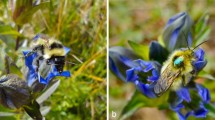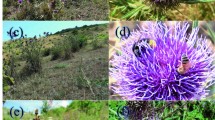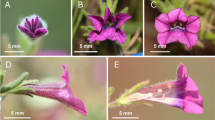Summary
The andromonoecious plant Aralia hispida has a complicated blooming schedule involving alternations between male and female phases.Nectar and pollen are released gradually through the day. Plants vary considerably in number of flowers per umbel and number of umbels per plant. The major pollinators, bumble bees, show several characteristic behaviors in response to the plant's presentation.
-
1.
Foraging bees preferentially visit umbels that bear large numbers of open, male-phase flowers. They also prefer shoots with large numbers of umbels.
-
2.
If bees have received high nectar rewards at one umbel, they are more likely to visit a neighboring umbel rather than leaving the area. On drained umbels, bees probe more empty flowers before rejecting the umbel if they have been rewarded just previously.
-
3.
Individual bees restrict their foraging to limited areas. Within these areas, they concentrate their visits on certain shoots which they tend to visit in repeatable sequences, or “traplines”. It is inappropriate to consider these bees as “searching”.
-
4.
We discuss some of the implications of these data for two areas of current theoretical interest: plant reproductive strategies and optimal foraging.
Similar content being viewed by others
References
Austin GH (1955) Effect of carbon dioxide anaesthesia on bee behavior and expectation of life. Bee Wld 36:45–47
Baker HG (1976) “Mistake pollination” as a reproductive system with special reference to the Caricaceae, pp. 161–169 in J. Burley and B.T. Styles (eds.). Tropical trees: variation, breeding, and conservation. Academic Press, London
Barrett SCH, Helenurm K (1981) Sex ratio and life history in Aralia nudicaulis (Araliaceae). Evolution 35:752–762
Barrett SCH, Thomson JD (1981) Spatial pattern, floral sex ratios, and fecundity in dioecious Aralia nudicaulis L. (Araliaceae). Can J Bot (in press)
Bawa KS (1980) Mimicry of male flowers and intra-sexual competition for pollinators in Jacaratia dolichaula (D. Smith) Woodson (Caricaceae). Evolution 34:467–474
Bawa KS, Keegan CR, and Voss RH (1982) Sexual dimorphism in Aralia nudicaulis L. (Araliaceae) Evolution 36:371–378
Beattie AJ (1971a) A technique for the study of insect-borne pollen. Pan Pacif Ent 47:82
Beattie AJ (1971b) Pollination mechanisms in Viola. New Phytol. 70:343–360
Beattie AJ, Breedlove DE and Ehrlich PR (1973) The ecology of the pollinators and predators of Frasera speciosa. Ecology 54:81–91
Cruden RW and Hermann-Parker SM (1977) Temporal dioecism: an alternative to dioecism. Evolution 31:863–866
Darwin C (1876) The effects of cross and self fertilisation in the vegetable kingdom. Murray, London
Davies NB and Houston AI (1981) Owners and satellites: the economics of territory defence in the pied wagtail, Motacilla alba. J Anim Ecol 50:157–180
Gill FB and Wolf LL (1977) Nonradom foraging by sunbirds in a patchy environment. Ecology 58:1284–1296
Hartling L and Plowright RC (1979) Foraging by bumble bees on patches of artificial flowers: a laboratory study. Can J Zool 57:1866–1870
Heinrich B (1976) The foraging specializations of individual bumblebees. Ecol Monogr 46:105–128
Heinrich B (1979a) Bumblebee economics. Harvard Univ Press, Cambridge, Mass
Heinrich B (1979b) “Majoring” and “minoring” by foraging bumblebees, Bombus vagans: an experimental analysis. Ecology 60:245–255
Heinrich B (1979c) Resource heterogeneity and patterns of movement in foraging bumblebees. Oecologia 40:235–245
Heinrich B, Mudge PR and Deringis PG (1977) A Laboratory analysis of flower constancy in foraging bumblebees: Bombus ternarius and B. terricola. Benav Ecol Socibiol 2:247–266
Janzen DH (1971) Euglossine bees as long-distance pollinators of tropical plants. Science 171:203–205
Janzen DH (1977) A note on optimal mate selection by plants. Amer Natur 111:365–371
Kevan PG (1976) Fluorescent nectar. Science 194:341–342
Levin DA and Kerster HW (1973) Assortative pollination for stature in Lythrum salicaria. Evolution 27:144–152
Lloyd DG (1980) The distributions of gender in four angiosperm species illustrating two evolutionary pathways to dioecy. Evolution 34:123–134
Manning A (1956) Some aspects of the foraging behaviour of bumble-bees. Behaviour 9:164–201
O'Brien MH (1980) The pollination biology of a pavement plain: pollinator visitation patterns. Oecologia 47:213–218
Oster G and Heinrich B (1976) Why do bumblebees major? A mathematical model. Ecol Monogr 46:129–133
Pesenko YA (1972) Method of counting insect pollinators. Soviet J Ecol 3:68–73
Pleasants JM and Zimmerman M (1979) Patchiness in the dispersion of nectar resources: evidence for hot and cold spots. Oecologia 41:283–288
Pomeroy N and Plowright RC (1979) Larval ejection following CO2 narcosis of bumble bees (Hymenoptera: Apidae). J Kans Ent Soc 52:215–217
Pyke GH (1974) Studies in the foraging efficiency of animals. Ph D dissertation, University of Chicago
Pyke GH (1978a) Optimal foraging: movement patterns of bumblebees between inflorescences. Theor Pop Biol 13:72–98
Pyke GH (1978b) Optimal foraging in bumblebees and coevolution with their plants. Oecologia 36:281–291
Pyke GH (1979) Optimal foraging in bumblebees: rule of movement between flowers within inflorescences. Anim Behav 27:1167–1181
Ribbands CR (1949) The foraging method of individual honeybees. J Anim Ecol 18:47–66
Ribbands CR (1950) Changes in the behaviour of honey-bees following their recovery from anaesthesia. J Exp Biol 27:302–310
Schemske DW (1980) Evolution of floral display in the orchid Brassavola nodosa. Evolution 34:489–493
Singh S (1950) Behavior studies of honeybees in gathering nectar and pollen. Bull Cornell agric exp sta 288:1–59
Sokal RR and Rohlf FJ (1969) Biometry. WH Freeman, San Francisco 776 pp
Thomson JD (1981) Field measures of constancy in bumble bees. Am Midl Nat 105:377–380
Thomson JD and Barrett SCH (1981) Temporal variation of gender in Aralia hispida Vent. (Araliaceae). Evolution 35:1094–1107
Thomson JD and Plowright RC (1980) Pollen carryover, nectar rewards, and pollinator behavior with special reference to Diervilla lonicera. Oecologia 46:68–74
Thorp RW, Briggs DL and Erikson EH (1975) Nectar fluorescence under ultraviolet irradiation. Science 189:476–478
Waddington KD (1979b) Quantification of the movement patterns of bees: a novel method. Amer Midl Natur 101:278–285
Waddington KD (1980) Flight patterns of foraging bees relative to density of artificial flowers and distribution of nectar. Oecologia 44:199–204
Waddington KD and Heinrich B (1979) The foraging movements of bees on vertical “inflorescences”: an experimental analysis. J Comp Physiol 134:113–117
Waddington KD and Holden LR (1979) Optimal foraging: on flower selection by bees. Amer Natur 114:179–196
Willson MF (1979) Sexual selection in plants. Amer Natur 113:777–790
Willson MF and Price PW (1977) The evolution of inflorescence size in Asclepias (Asclepiadaceae). Evolution 31:495–511
Willson MF and Rathcke BJ (1974) Adaptive design of the floral display in Asclepias syriaca L Amer Midl Natur 92:47–57
Zimmerman M (1979) Optimal foraging: a case for random movement. Oecologia 43:261–267
Author information
Authors and Affiliations
Rights and permissions
About this article
Cite this article
Thomson, J.D., Maddison, W.P. & Plowright, R.C. Behavior of bumble bee pollinators of Aralia hispida Vent. (Araliaceae). Oecologia 54, 326–336 (1982). https://doi.org/10.1007/BF00380001
Received:
Issue Date:
DOI: https://doi.org/10.1007/BF00380001




